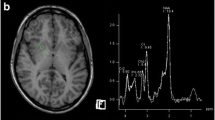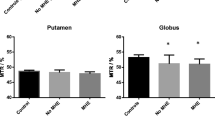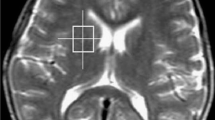Abstract
The purpose of this study was to correlate the hyperintensity in the globus pallidus seen on T1-weighted magnetic resonance imaging (MRI) of the brain in chronic liver disease with changes in metabolite ratios measured from both proton and phosphorus-31 magnetic resonance spectroscopy (MRS) localised to the basal ganglia. T1-weighted spin echo (T1 WSE) images were obtained in 21 patients with biopsy-proven cirrhosis (nine Child's grade A, eight Child's grade B and four Child's grade C). Four subjects showed no evidence of neuropsychiatric impairment on clinical, psychometric and electrophysiological testing, four showed evidence of subclinical hepatic encephalopathy and 13 had overt hepatic encephalopathy. Signal intensities of the globus pallidus and adjacent brain parenchyma were measured and contrast calculated, which correlated with the severity of the underlying liver disease, when graded according to the Pugh's score (p<0.05). Proton MRS of the basal ganglia was performed in 12 patients and 14 healthy volunteers. Peak area ratios of choline (Cho), glutamine and glutamate (Glx) and N-acetylaspartate relative to creatine (Cr) were measured. Significant reductions in mean Cho/Cr and elevations in mean Glx/Cr ratios were observed in the patient population. Phosphorus-31 MRS of the basal ganglia was performed in the remaining nine patients and in 15 healthy volunteers. Peak area ratios of phosphomonoesters (PME), inorganic phosphate, phosphodiesters (PDE) and phosphocreatine relative to BATP (ATP) were then measured. Mean values of PME/ATP and PDE/ATP were significantly lower in the patient population. No correlation was found between the T1WSE MRI contrast measurements of the globus pallidus and the abnormalities in the metabolite ratios measured from either proton or phosphorus-31 MR spectra. Our results suggest that pallidal hyperintensity seen on T1WSE MR imaging of patients with chronic liver disease is not related to the functional abnormalities of the brain observed in hepatic encephalopathy.
Similar content being viewed by others
References
Barbara, L., Barbiroli, B., Gaiani, S., Bolondi, L., Sofia, S., Zironi, G.et al. (1993). Abnormal brain energy metabolism assessed by31P MRS in liver cirrhosis.Hepato-Gastroenterol. 40:6/0.
Barbiroli, B., Lodi, R., Sama, C., Bolondi, L., Malavolti, M., Brillanti, S.et al. (1992). Abnormal brain energy metabolism detected by31PMRS in patients with chronic liver disease.Proc. 11th Ann. Mtg. Soc. Magn. Reson. Med. 3:1919.
Bottomley, P.A., Hart, H.R., Edelstein, W.A., Schenk, J.F., Smith, L.S., Leue, W.M.et al. (1984). Anatomy and metabolism of the normal human brain studied by magnetic resonance at 1.5 Tesla.Radiology 150:441–446.
Bruhn, H., Merboldt, K.D., Michaelis, T., Gyngell, M.L., Hänicke, W., Frahm, J.et al. (1991). Proton MRS of metabolic disturbances in the brain of patients with liver cirrhosis and subclinical hepatic encephalopathy.Proc. 10th Ann. Mtg. Soc. Magn. Reson. Med. 1: 400.
Brunberg, J.A., Kanal, E., Hirsch, W., and Van Thiel, D.H. (1991). Chronic acquired hepatic failure: MR imaging of the brain at 1.5 T.Am. J. Neuro. Radiol. 12: 909–914.
Bryant, D.J., Weeks, R.A., Marcus, C.D., Sargentoni, J., Taylor-Robinson, S., and Brooks, D.J. (1994). Glutamate in Huntington's disease.Lancet. 344:189–190.
Butterworth, R.F., Giguere, J.F., Michaud, J., Lavoie, J., and Layrargues, G.P. (1987). Ammonia: key factor in the pathogenesis of hepatic encephalopathy.Neurochem. Pathol. 6:1–12.
Butterworth, R.F., Spahr, L., Fontaine, S., and Pomier Layrargues, G. (1995). Manganese toxicity, dopaminergic dysfunction and hepatic encephalopathy.Metab. Brain Dis. 10:259–267.
Chamuleau, R.A., Bosman, D.K., Bovée, W.M.M.J., Luyten, P.R., and den Hollander, J.A. (1991a). What the clinician can learn from MR glutamine/glutamate assays.NMR Biomed. 4:103–108.
Chamuleau, R.A.F.M., Bosman, D.K., Bovée, W.M.M.J., Luyten, P.R., and Barkhof, F. (1991b). Chronic hepatic encephalopathy studied by NMR spectroscopy and MRI in man.J. Hepatol. 13 (Suppl 2):S19.
Conn, H.O. (1977). Trail making and number-connection tests in the assessment of mental state in portal systemic encephalopathy.Am. J. Dig. Dis. 22:541–550.
Conn, H.O., Leevy, C.M., Vlahcevic, Z.R., Rodgers, J.B., Madrey, W.C., Seeff, L., and Leevy, L.L. (1977). Comparison of lactulose and neomycin in the treatment of chronic portal-systemic encephalopathy: a double blind trial.Gastroenterology 72:573–583.
Cooper, A.J.L., and Plum, F. (1987). Biochemistry and physiology of brain ammonia.Physiol. Rev. 67:440–519.
Coutts, G.A., Cox, I.J., Gadian, D.G., Sargentoni, J., Bryant, D.J., and Collins, A.G. (1989). Phosphorus-31 magnetic resonance spectroscopy of the normal human brain. Approaches using four-dimensional chemical shift imaging and phase mapping techniques.NMR Biomed. 1:190–197.
Dagnelie, P.C., Menon, D.K., Cox, I.J., Bell, J.D., Sargentoni, J., Urenjak, J., and Iles, R.A. (1992). Effect of L-alanine infusion on31P magnetic resonance of the normal liver: towardsin vivo biochemical pathology.Clin Science.83:183–190.
DeSouza, N.M., Hajnal, J.V., and Baudouin, C.J. (1995). Potential for increasing conspicuity of short T1 lesions in the brain using magnetisation transfer imaging.Neuroradiology 37:278–283.
Ernst, R.R., and Anderson, W.A. (1966). Application of fourier transform spectroscopy to magnetic resonance.Rev. Sci. Instrum. 37:93.
Gupta, R.K., Saraswat, V.A., Poptani, H., Dhiman, R.K., Kohli, A., Gujral, R.B., and Naik, S.R. (1993). Magnetic resonance imaging and localisedin vivo proton spectroscopy in patients with fulminant hepatic failure.Am. J. Gastroenterol. 88:670–674.
Haussinger, D., Laubenberger, J., vom Dahl, S., Ernst, T., Bayer, S., Langer, M., Gerok, W., Hennig, J. (1994). Proton magnetic resonance spectroscopy studies on human brain myo-inositol in hypo-osmolarity and hepatic encephalopathy.Gastroenterology 107:1475–1480.
Hawkins, R.A., Mans, A.M., and Biebuyk, J.F. (1987). Changes in brain metabolism in hepatic encephalopathy.Neurochem. Pathol. 6:35–66.
Hilgier, W., Benveniste, H., Diemer, N.H., and Albrecht, J. (1991). Decreased glucose utilisation in discrete brain regions of rat in thioacetamide-induced hepatic encephalopathy as measured with (3H)-deoxyglucose.Acta Neurol. Scand. 83:353–355.
Inoue, E., Hori, S., Narumi, Y., Fujita, M., Kuriyama, K., Kadota, T., and Kuroda, C. (1991). Portal-systemic encephalopathy: presence of basal ganglia lesions with high signal intensity on MR images.Radiology 179:551–555.
James, J.H., Escourrou, J., and Fischer, J.E. (1978). Blood-brain neutral amino acid transport activity is increased after portacaval anastomosis.Science 200:1395–1397.
Jessy, J., De Joseph, M.R., and Hawkins, R.A. (1990). Hyperammonaemia depresses glucose consumption throughout the brain.Biochem. J. 277:693–696.
Kendrick, D.C., Gibson, A.J., and Moyes, I.G.A. (1979). The revised Kendrick battery: clinical studies.Br. J. Soc. Clin. Psychol. 18:329–339.
Kreis, R., Farrow, N., and Ross, B.D. (1991). Localised1H NMR spectroscopy in patients with chronic hepatic encephalopathy. Analysis of changes in cerebral glutamine, choline and inositols.NMR Biomed. 4:109–116.
Kreis, R., Ross, B.D., Farrow, N.A., and Ackerman, Z. (1990). Diagnosis of hepatic encephalopathy by proton magnetic resonance spectroscopy.Lancet 336:635–636.
Kreis, R., Ross, B.D., Farrow, N.A., and Ackerman, Z. (1992). Metabolic disorders of the brain in chronic hepatic encephalopathy detected with H-1 MR spectroscopy.Radiology 182:19–27.
Krieger, D., Krieger, S., Jansen O., Gass, P., Theilmann, L., and Lichtnecker, H. (1995). Manganese and chronic hepatic encephalopathy. Lancet346:270–274.
Kulisevsky, J., Pujol, J., Balanzo, J., Junqué, C., Deus, J., Capdevilla, A., and Villanueva, C. (1992). Pallidal hyperintensity on magnetic resonance imaging in cirrhotic patients: clinical correlations.Hepatology 16:1382–1388.
Levy, L.M., Yang, A., Hennigar, R., Rothstein, J., and Bryan, R.N. (1989). The brain and hepatic encephalopathy MR abnormalities.Am. J. Neuro. Radiol. 10:904.
Luyten, P.R., den Hollander, J.A., Bovée, W.M.M.J., Ross B.D., Bosman, D.K., and Chamuleau, R.A.F.M. (1989).31P and1H NMR spectroscopy of the human brain in chronic hepatic encephalopathy.Proc. 8th Ann. Mtg. Soc. Magn. Reson. Med. I:375.
Miller, L. (1991). A review of chemical issues in1H NMR spectroscopy: N-acetyl aspartate, creatine and choline.NMR in Biomed. 4:47–52.
Mirowitz, S.A., Sartor, K., and Gado, M. (1989). High-intensity basal ganglia lesions on T1-weighted MR images in neurofibromatosis.Am. J. Neuro. Radiol. 10:1159–1163.
Mirowitz, S.A., Westrich, T.J., and Hirsch, J.D. (1991). Hyperintense basal ganglia on T1-weighted MR images in patients receiving parenteral nutrition.Radiology 181:117–120.
Morgan, M.Y., Alonso, M., and Stanger, L.C. (1989). Lactitol and lactulose for the treatment of subclinical hepatic encephalopathy in cirrhotic patients.J. Hepatol. 8:208–217.
Nelson, K., Golnick, J., Korn, T., and Angle, C. (1993). Manganese encephalopathy: utility of early magnetic resonance imaging.Br. J. Ind. Med. 40:510–513.
Norenberg, M.D. (1987). The role of astrocytes in hepatic encephalopathy.Neurochem. Pathol. 6: 13–33.
Norton, N.S., McConnell, J.R., Zetterman, R.K., and Rodriguez-Sierra, J.F. (1994). A quantitative evaluation of magnetic resonance image signal changes of the brain in chronic hepatic encephalopathy.J. Hepatol. 21:764–770.
Pomier-Layrargues, G., Shapcott, D., Spahr, L., and Butterworth, R.F. (1995a). Accumulation of manganese and copper in the pallidum of cirrhotic patients: role in the pathogenesis of hepatic encephalopathy?Metab. Brain Dis. 10:351–354.
Pomier-Layrargues, G., Spahr, L., and Butterworth, R.F. (1995b). Increased manganese concentrations in pallidum of cirrhotic patients.Lancet 345:735.
Pugh, R.N.H., Murray-Lyon, I.M., Dawson, J.L., Pietroni, M.C., and Williams, R. (1972). Transection of the oesophagus for bleeding oesophageal varices.Br. J. Surg. 60:646–649.
Pujol, A., Graus, F., Peri, J., Mercader, J.M., and Rimola, A. (1991). Hyperintensity in the globus pallidus on T1-weighted and inversion-recovery MRI: a possible marker of advanced liver disease.Neurology 41:1526–1527.
Pujol, A., Pujol, J., Graus, F., Rimola, A., Peri, J., Mercader, J.M.et al. (1993). Hyperintense globus pallidus on T1-weighted MRI in cirrhotic patients is associated with severity of liver failure.Neurology 43:65–69.
Quero, J.C., Huizenga, J.R., Chamuleau, R.A.F.M., Blijenberg, B.G., Gips, C.H., and Schalm, S.W. (1993). Determination of ammonia in capillary and arterial blood simultaneously using the BAC II.Hepato-Gastroenterol. 40:81.
Ross, B.D., Jacobsen, S., Villamil, F., Korula, J., Ernst, T., Shonk, T., and Moats, R.A. (1994). Subclinical hepatic encephalopathy: proton MR spectroscopic abnormalities.Radiology 193:457–463.
Ross, B.D., Kreis, R., and Ernst, T. (1992). Clinical tools for the 90s: magnetic resonance spectroscopy and metabolite imaging.Eur. J. Rad. 14:128–140.
Ross, B.D., Morgan, M.Y., Cox, I.J., fnHawley, K.E., and Young, I.R. (1987). Continuing defect in cerebral energy metabolism in patients with persistent encephalopathy (PHE): monitoring with31P MRS.Clin. Sci. 72 (Suppl 16):26P.
Ruiz-Cabello, J., and Cohen, J.S. (1992). Phospholipid metabolites as indicators of cancer cell function.NMR Biomed. 5:226–233.
Saeed, N. (1995). A knowledge based approach to deconvolve the water component inin vivo proton MR spectroscopy.J. Comput. Assist. Tomogr. 19:830–837.
Saeed, N., and Menon, D.K. (1993). A knowledge-based approach to minimise baseline roll in chemical shift imaging.Magn. Reson. Med. 29:591–598.
Schenker, S., and Brady, C.E., III (1994). Pathogenesis of hepatic encephalopathy. In (H.O. Conn, and J. Bircher, eds.)Hepatic Encephalopathy: Syndromes and Therapies. Medi-Ed Press, Bloomington pp 43–61.
Syh, H.W., Chu, W.K., Mar N., and McConnell, J.R. (1991). An image analysis on MR imaging of the brain for hepatic encephalopathy.Biomed. Sci. Instrum. 27:29–33.
Taylor-Robinson, S.D., Oatridge, A., Hajnal, J.V., Burroughs, A.K., McIntyre, N., and deSouza, N.M. (1995). MR Imaging of the basal ganglia in chronic liver disease: Correlation of T1-weighted and magnetisation transfer contrast measurements with liver dysfunction and neuropsychiatric status.Metab. Brain Dis. 10:175–188.
Taylor-Robinson, S.D., Sargentoni, J., Mallalieu, R.J., Bell, J.D., Bryant, D.J., Coutts, G.A., and Morgan, M.Y. (1994a). Cerebral phosphorus-31 magnetic resonance spectroscopy in patients with chronic hepatic encephalopathy.Hepatology 20:1173–1178.
Taylor-Robinson, S.D., Sargentoni, J., Marcus, C.D., Morgan, M.Y., and Bryant, D.J. (1994b). Regional variations in cerebral proton spectroscopy in patients with chronic hepatic encephalopathy.Metab. Brain Dis. 9:347–359.
Taylor-Robinson, S.D., Weeks, R.A., Sargentoni, J., Marcus C.D., Bryant, D.J., Harding, A.C., and Brooks, D.J. (1994c). Evidence for glutamate excitotoxicity in Huntington's disease with proton magnetic resonance spectroscopy.Lancet 343:1170.
Thuluvath, P.J., Edwin, D., Yue, N.C., deVilliers, C., Hochman, S., and Klein, A. (1995). Increased signals seen in globus pallidus in T1-weighted magnetic resonance imaging in cirrhotics are not suggestive of chronic hepatic encephalopathy.Hepatology 21:440–442.
Versieck, J., Barbier, F., Speecke, A., and Hoste, J. (1974). Manganese, copper and zinc concentrations in serum and packed blood cells during acute hepatitis, chronic hepatitis, and posthepatic cirrhosis.Clin. Chem. 20:1141–1145.
Victor, M., Adams, R.D., and Cole, M. (1965). The acquired (non-Wilsonian) type of chronic hepatocerebral degeneration.Medicine 44:345–396.
Voorhies, T.M., Ehrlich, M.E., Duffy, T.E., Petito, C.K., and Plum, F. (1983). Acute hyperammonaemia in the young primate: physiologic and neuropathologic correlates.Pediatr. Res. 17:970–975.
Wechsler, D. (1955).Wechsler Adult Intelligence Scale Manual. New York: Psychological Corporation.
Weissenborn, K., Ehrenheim, C., Hori, A., Kubicka, S., and Manns, M.P. (1995). Pallidal lesions in patients with liver cirrhosis: clinical and MRI evaluation.Metab. Brain Dis. 10:219–238.
Zeneroli, M.L., Cioni, G., Crisi, G., Vezzelli, C., and Ventura, E. (1991). Globus pallidus alterations and brain atrophy in liver cirrhosis patients with encephalopathy: an MR imaging study.Magn. Reson. Imaging 9:295–302.
Author information
Authors and Affiliations
Rights and permissions
About this article
Cite this article
Taylor-Robinson, S.D., Sargentoni, J., Oatridge, A. et al. MR imaging and spectroscopy of the basal ganglia in chronic liver disease: Correlation of T1-weighted contrast measurements with abnormalities in proton and phosphorus-31 MR spectra. Metab Brain Dis 11, 249–268 (1996). https://doi.org/10.1007/BF02237962
Received:
Accepted:
Issue Date:
DOI: https://doi.org/10.1007/BF02237962




